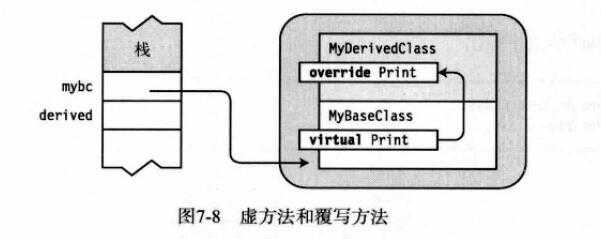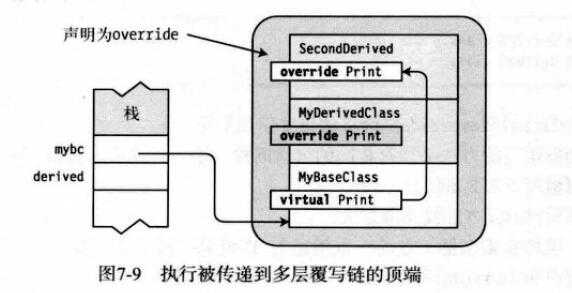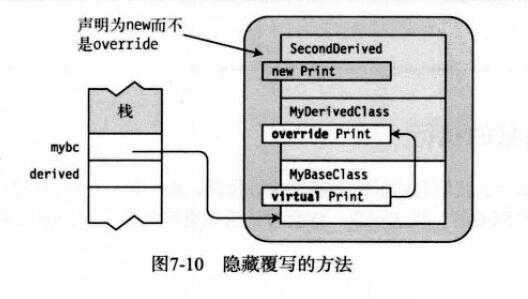review——C# (6)虚方法和覆写方法
2021-04-07 21:27
标签:类的成员 条件 其他 OLE 关于 演示 int 重写 com FROM P125 在上一节中看到,当使用基类引用访问派生类对象时,得到的是基类的成员。虚方法可以使基类的引用访问“升至”派生类内。 可以使用基类引用调用派生类(derived class)的方法,只需满足下列条件: □派生类的方法和基类的方法有相同的签名和返回类型 □基类的方法使用virtual标注 □派生类的方法使用override标注 使用方法如下例: 与上一节中不同,使用基类引用调用Print方法时,方法调用被传递到派生类并执行,因为: □基类的方法被标记为virtual □派生类中有匹配的override方法 如下图所示,显示了一个从virtual Print方法后面开始,并指向override Print方法的箭头 具体示例如下: 其他的一些关于virtual和override的信息有: □覆写和被覆写的方法必须有相同的可访问性。e.g.不能是 被覆写是private 而覆写的是public □不能覆写static方法或非虚方法 □方法、属性、索引器,以及另一种成员类型事件,都可以被声明为virtual和override Part2 覆写标记为override的方法: 覆写方法可以在继承的任何层次中出现 □当使用对象基类部分的引用调用一个覆写的方法时,方法的调用被沿派生层次上溯执行,一直到标记为override的方法的最高派生(most-derived)版本。 □如果在更高的派生级别有该方法的其他声明,但没有被标记为override,那么它们不会被调用 以以下实例来说明,其中三个类构成一个继承的层次: MyBaseClass、MyDerivedClass和SecondDerived。其均包含名称为Print的方法,并带有相同的签名。且分别被标记为virtual、override、 override/new 分别看一下第三个类标记为这两个的结果。 1.情况1:使用override声明Print 如果把SecondDerived的Print方法声明为override,那么它会覆写方法的全部两个低派生级别的版本,如下图所示,如果一个基类的引用被用于调用Print,它会向上传递通过整个链达到类SecondDerived中的实现。 结果是:无论Print是通过派生类调用还是通过基类调用,都会调用最高派生类中的方法。当通过基类调用时,调用被沿着继承层次向上传递。 2.情况2:使用new声明Print 结果是:当方法Print通过SecondDerived的引用调用时,SecondDerived中的方法被执行,正如所期待的那样。然而,当方法通过MyBaseClass的引用调用时,方法调用只向上传递了一级,到达类MyDerived,在那里它被执行。 本来想使用下列代码进行 virtual -> override -> new ->override 的检验 然而编译器报错为“ThirdDerived.Print()”: 继承成员“SecondDerived.Print()”未标记为 virtual、abstract 或 override,无法进行重写。 不过,当试验virtual-> override->new ->virtual ->override 时却是可以的,而实际上,这个中间多出的virtual是在对之前的一系列方法进行隐藏,即这个virtual其实应该写作 new virtual。 综上,对覆写方法的总结为: 通过某个引用对方法进行调用时,实际执行的是从这里出发,连续的一段override覆写中的最后一个的方法。(中间不可以用virtual隔开)。 Part3 覆盖其他成员类型 以上已经描述了如何在方法上使用virtual/override,事实上,在属性事件以及索引器上也是一样的。e.g.下面的代码演示了名为MyProperty的只读属性,其中使用了virtual/override 这里需要注意的是,最终执行下去返回的属性就是派生类的属性。 review——C# (6)虚方法和覆写方法 标签:类的成员 条件 其他 OLE 关于 演示 int 重写 com 原文地址:https://www.cnblogs.com/quintessence/p/9100751.html1 class MyBaseClass //基类
2 {
3 virtual public void Print();
4 }
5 class MyDerivedClass : MyBaseClass //派生类
6 {
7 override public void Print()
8 }

1 using System;
2 using System.Collections.Generic;
3 using System.Linq;
4 using System.Text;
5 using System.Threading.Tasks;
6
7 namespace review
8 {
9 class MyBaseClass //基类
10 {
11 virtual public void Print()
12 {
13 Console.WriteLine("This is the base class.");
14 }
15 }
16 class MyDerivedClass : MyBaseClass //派生类
17 {
18 override public void Print()
19 {
20 Console.WriteLine("This is the derived class.");
21 }
22 }
23 class Program
24 {
25 static void Main(string[] args)
26 {
27 MyDerivedClass derived = new MyDerivedClass();
28 MyBaseClass mybc = (MyBaseClass)derived; //强制转换成基类
29 derived.Print();
30 mybc.Print();
31 Console.Read();
32 }
33 }
34 }
35 /*
36 * 输出如下:
37 * This is the derived class.
38 * This is the derived class.
39 * */
1 class MyBaseClass //基类
2 {
3 virtual public void Print()
4 {
5 Console.WriteLine("This is the base class.");
6 }
7 }
8 class MyDerivedClass : MyBaseClass //派生类
9 {
10 override public void Print()
11 {
12 Console.WriteLine("This is the derived class.");
13 }
14 }
15 class SecondDerived : MyDerivedClass //最高派生类
16 {
17 ...// Given in the following pages
18 }

1 using System;
2 using System.Collections.Generic;
3 using System.Linq;
4 using System.Text;
5 using System.Threading.Tasks;
6
7 namespace review
8 {
9 class MyBaseClass //基类
10 {
11 virtual public void Print()
12 {
13 Console.WriteLine("This is the base class.");
14 }
15 }
16 class MyDerivedClass : MyBaseClass //派生类
17 {
18 override public void Print()
19 {
20 Console.WriteLine("This is the derived class.");
21 }
22 }
23 class SecondDerived : MyDerivedClass //最高派生类
24 {
25 public override void Print()
26 {
27 Console.WriteLine("This is the second derived class.");
28 }
29 }
30 class Program
31 {
32 static void Main(string[] args)
33 {
34 SecondDerived derived = new SecondDerived();
35 MyBaseClass mybc = (MyBaseClass)derived; //强制转换成基类
36
37 derived.Print();
38 mybc.Print();
39 Console.Read();
40 }
41 }
42 }
43 /*
44 * 输出如下:
45 * This is the second derived class.
46 * This is the second derived class.
47 * */
1 using System;
2 using System.Collections.Generic;
3 using System.Linq;
4 using System.Text;
5 using System.Threading.Tasks;
6
7 namespace review
8 {
9 class MyBaseClass //基类
10 {
11 virtual public void Print()
12 {
13 Console.WriteLine("This is the base class.");
14 }
15 }
16 class MyDerivedClass : MyBaseClass //派生类
17 {
18 override public void Print()
19 {
20 Console.WriteLine("This is the derived class.");
21 }
22 }
23 class SecondDerived : MyDerivedClass //最高派生类
24 {
25 new public void Print()
26 {
27 Console.WriteLine("This is the second derived class.");
28 }
29 }
30 class Program
31 {
32 static void Main(string[] args)
33 {
34 SecondDerived derived = new SecondDerived();
35 MyBaseClass mybc = (MyBaseClass)derived; //强制转换成基类
36
37 derived.Print();
38 mybc.Print();
39 Console.Read();
40 }
41 }
42 }
43 /*
44 * 输出如下:
45 * This is the second derived class.
46 * This is the derived class.
47 * */

1 class ThirdDerived : SecondDerived
2 {
3 override public void Print()
4 {
5 Console.WriteLine("This is the third derived class.");
6 }
7 }
1 using System;
2 using System.Collections.Generic;
3 using System.Linq;
4 using System.Text;
5 using System.Threading.Tasks;
6
7 namespace review
8 {
9 class MyBaseClass //基类
10 {
11 virtual public void Print()
12 {
13 Console.WriteLine("This is the base class.");
14 }
15 }
16 class MyDerivedClass : MyBaseClass //派生类
17 {
18 override public void Print()
19 {
20 Console.WriteLine("This is the derived class.");
21 }
22 }
23 class SecondDerived : MyDerivedClass //最高派生类
24 {
25 new public void Print()
26 {
27 Console.WriteLine("This is the second derived class.");
28 }
29 }
30 class ThirdDerived : SecondDerived
31 {
32 new virtual public void Print()
33 {
34 }
35 }
36 class FourthDerived : ThirdDerived
37 {
38 override public void Print()
39 {
40 Console.WriteLine("This is the fourth derived class.");
41 }
42 }
43 class Program
44 {
45 static void Main(string[] args)
46 {
47 FourthDerived derived = new FourthDerived();
48 MyBaseClass mybc = (MyBaseClass)derived; //强制转换成基类
49
50 derived.Print();
51 mybc.Print();
52 Console.Read();
53 }
54 }
55 }
56 /*
57 * 输出如下:
58 * This is the fourth derived class.
59 * This is the derived class.
60 * */
1 using System;
2 using System.Collections.Generic;
3 using System.Linq;
4 using System.Text;
5 using System.Threading.Tasks;
6
7 namespace review
8 {
9 class MyBaseClass //基类
10 {
11 private int _mInt = 5;
12 virtual public int MyProperty
13 {
14 get { return _mInt; }
15 }
16 }
17 class MyDerivedClass : MyBaseClass //派生类
18 {
19 private int _mInt = 10;
20 public override int MyProperty
21 {
22 get
23 {
24 return _mInt;
25 }
26 }
27 }
28 class Program
29 {
30 static void Main(string[] args)
31 {
32 MyDerivedClass derived = new MyDerivedClass();
33 MyBaseClass mybc = (MyBaseClass)derived; //强制转换成基类
34
35 Console.WriteLine(derived.MyProperty);
36 Console.WriteLine(mybc.MyProperty);
37 Console.Read();
38 }
39 }
40 }
41 /*
42 * 输出如下:
43 * 10
44 * 10
45 * */